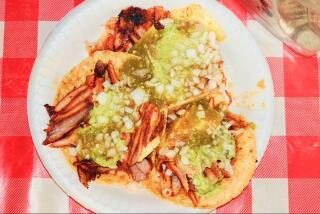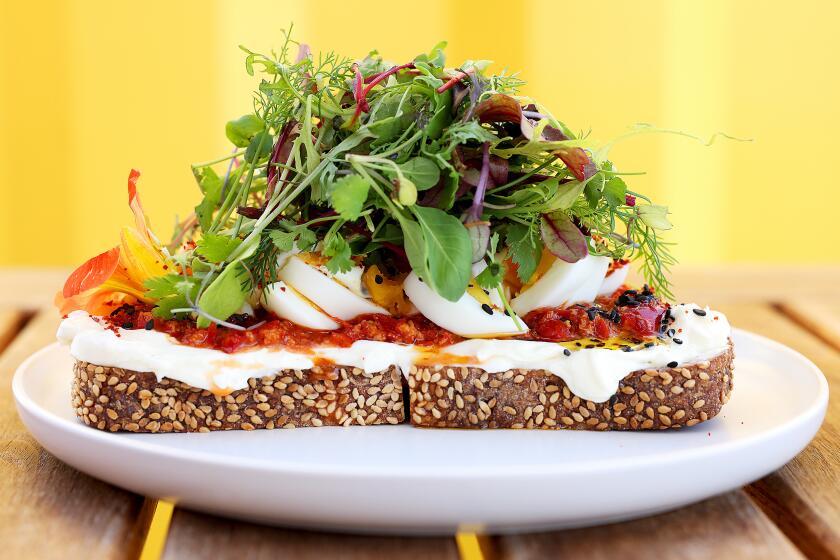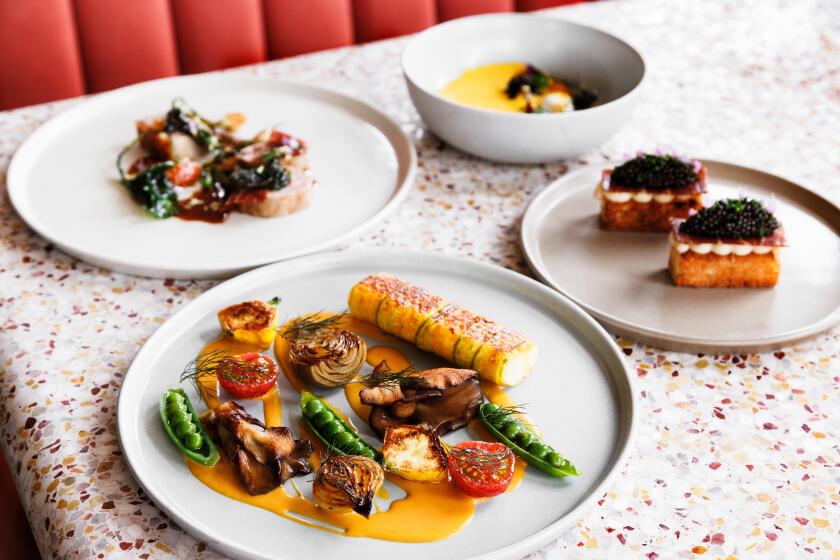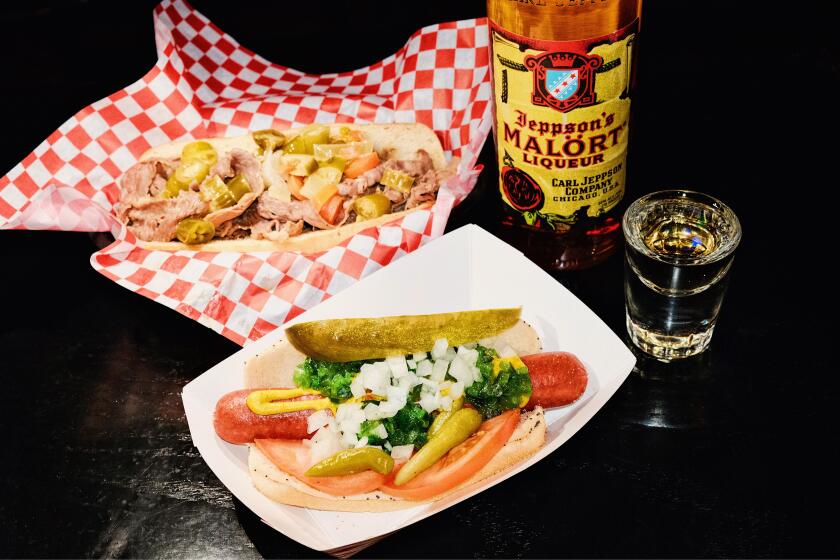Juan Valdez pours fresh cup to get cafe cachet
The ever-faithful mule is still by his side, the poncho neatly draped over his shoulder, the straw hat perched atop the serene, mustachioed visage.
But this is a new Juan Valdez -- younger, more vigorous, more eco-conscious -- a Colombian coffee grower for the hyper-caffeinated era of double lattes, triple shots and gourmet blends.
Venerable Juan Valdez, one of the most successful emblems of modern advertising, is getting a makeover. Whereas the old Juan was a fellow who would stroll into Mom’s kitchen and enjoy a cup of Folgers while gently plugging 100% cafe de Colombia, 21st century Juan now has his own line of beans that he’s brewing up at trendy coffeehouses.
“Juan Valdez is eternal,” declared Gabriel Silva, who heads the National Federation of Coffee Growers of Colombia, the trade group that first trotted out the figure almost half a century ago. “Our idea is to rejuvenate and reinforce the image of Juan Valdez, without losing his authenticity.”
It might be Juan’s biggest challenge yet: In the balance hangs the future of Colombia’s $1.5-billion coffee industry, which provides a livelihood for millions and imparts a measure of social stability in a nation long plagued by civil conflict.
Colombian coffee took a big hit starting in the late 1990s, when a glut of the bean depressed prices worldwide. Advertising budgets were slashed. Juan Valdez seemed headed for pop culture relic status.
“They cut advertising to practically zero, and that unfortunately was at the time when interest in gourmet coffee was growing,” said Rohit Deshpande, who teaches marketing students at Harvard Business School about Juan Valdez. “Now, they’re trying to get back into it.”
Today, the coffee crisis has ended and Colombian coffee is selling for more than double its price four years ago. But production is down compared with the early 1990s, and Colombia now ranks as the world’s third-largest producer, after Brazil and Vietnam, the latter a relatively recent coffee behemoth. Colombia is now emphasizing niche marketing and quality over quantity.
Colombian growers decided that Juan Valdez could again work his magic, in part because his name recognition remains extraordinary. Two years ago, he made the Madison Avenue Walk of Fame after consumers voting in an industry forum named him their favorite icon, beating out such stalwarts as Mr. Clean, the Jolly Green Giant, the California Raisins and the Kool-Aid Man. And many Colombians profess fierce pride in the figure, although he’s the creation of American ad men.
“Juan Valdez represents the high quality of Colombian coffee,” said Jairo Garcia, 24, a picker harvesting beans on a finca, or farm, amid the green-carpeted, rolling hills of central Colombia’s Quindio state. “He is a symbol of what we do.”
Today, a slimmer, more youthful man is playing the Valdez role. His outsize signature now adorns fashionable coffee shops in Colombia and as far away as Madrid, New York and, yes, Seattle. Mimicking Starbucks, the coffeehouses hawk Juan Valdez T-shirts, cups, to-go flasks, caps and more.
And Juan Valdez is no longer just a reassuring face on someone else’s coffee. The icon now boasts his own line of premium and organic blends, on sale at Wal-Mart and other venues.
“For years, Starbucks was eating the Colombian producers’ lunch,” said Bruce Bagley, a University of Miami professor who is writing a book on Colombian coffee. “Value is added when you sell coffee in a pretty package. There’s no value added just by growing the stuff and selling it in bulk bags.”
Whether the Juan Valdez revival will ensure long-term prosperity for an industry so subject to price fluctuations remains to be seen.
All Juan Valdez products come under the umbrella of the coffee growers federation, a nonprofit trade group, which says the earnings go into improvements for its 500,000-plus members, mostly small farmers. The current Juan Valdez, like his predecessor, is himself from the ranks of Colombian growers.
The Juan Valdez saga began in the late 1950s, with world coffee prices plunging and Colombian producers keen to differentiate their beans in a U.S. market where coffee was mostly a 5-cent cuppa joe, no cachet, no adornment.
Growers approached a legendary New York ad firm, Doyle Dane Bernbach, which also created trailblazing little-guy ads for the Volkswagen Beetle (“Think Small”) and Avis (“We Try Harder”). The persona of Juan Valdez, a name chosen for its ease of pronunciation among non-Spanish speakers, was born.
The first Juan, who debuted on black-and-white screens in 1960, was Jose Duval, a Cuban American actor living in New York. He was an immediate hit in a market where few people had given Colombia a second thought. Colombian coffee farmer Carlos Sanchez assumed the role in 1969, reinforcing the initial message of quality and steadfastness.
Later spots featured Juan Valdez and his mule, Conchita, turning up in grocery aisles, commuter trains and kitchen cupboards, hawking “100% Colombian coffee,” a label adopted by brands such as Folgers and Yuban. Airplanes and locomotives were shown reversing course after forgetting their hauls of Colombian coffee.
Subsequent ads, catering to a younger crowd, featured Juan Valdez surfing, snowboarding and hang-gliding. The slogan: “Take life by the beans.”
But plummeting coffee prices in the late 1990s sent the industry reeling, and Colombian growers have been seeking new strategies ever since.
One market they’re targeting now is their own compatriots.
Unlike Brazilians, Colombians are not especially large consumers of their best-known beverage. The highest-quality coffee was historically exported. The traditional Colombian cup of coffee, known as tinto (which also refers to red wine), was often bitter, watered down and lacking the full-bodied, mellow taste associated with cafe de Colombia. Cafes tend to be dank mom-and-pop affairs, reeking of fried food. The domestic coffee market remains largely untapped.
“We have to teach people to ask for cafe, not tinto!” said Jaime Raul Duque, who heads a coffee-tasting lab. “Tinto is wine!”
Judging by the crowds lining up at Juan Valdez emporiums in cities like Bogota and Cartagena, the locals are starting to get it. The Juan Valdez decor is more utilitarian than at Starbucks, but the variety of Colombian bulk coffee on sale is substantial, including labels by region and topography (mountaintop, hillside, volcano).
On the menu: varieties of cappuccino, cafe con leche and a frozen concoction, all acquired tastes here. You can still get a cup of java for the equivalent of about a buck.
“I come to Juan Valdez every day,” said Melisa Luisa Andrade, who was having a coffee with a fellow tourism worker in an upscale northern district of Bogota. “I wouldn’t miss it.”
That’s good news for David Altschul, whose Portland, Ore., firm, Character, helped reshape Juan Valdez. He is played by Carlos Castaneda, 41, a coffee farmer and father of three from the appropriately named town of Andes, in the Antioquia region.
Castaneda was chosen after a two-year search that involved branding consultants, casting agents, psychologists, physical trainers, coffee executives and agronomists, among others. Screeners filtered more than 400 mustachioed hopefuls.
Some compared the procedure to a papal succession -- but there have been more popes in the last half-century than Juan Valdezes. Castaneda received the poncho and mule in a formal hand-over ceremony staged to melancholy music and memorialized on YouTube. Castaneda, who had never flown in an airplane before winning his post, seems to have quickly warmed to being a traveling trademark and celebrity. Altschul ran into him recently at a coffee confab in Arizona.
“He had just gotten back from Tokyo, and as soon as he was finished in Phoenix, he was heading off to Moscow,” Altschul said. “But he was as solid and well-grounded and charming as when I first saw him in Colombia. He hasn’t let this global icon status go to his head at all.”
patrick.mcdonnell@latimes.com
More to Read
Eat your way across L.A.
Get our weekly Tasting Notes newsletter for reviews, news and more.
You may occasionally receive promotional content from the Los Angeles Times.










